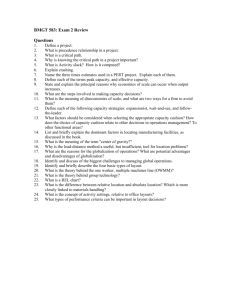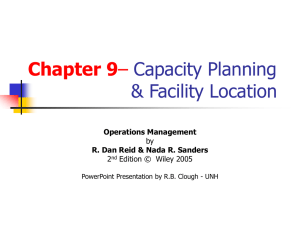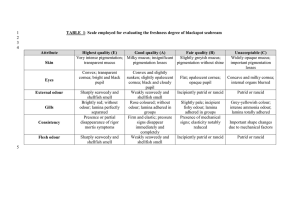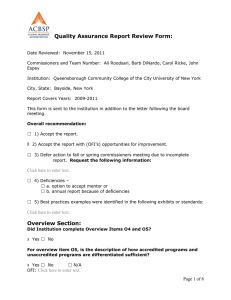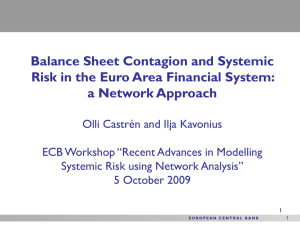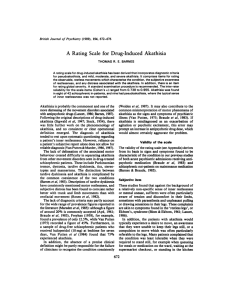facility location
advertisement
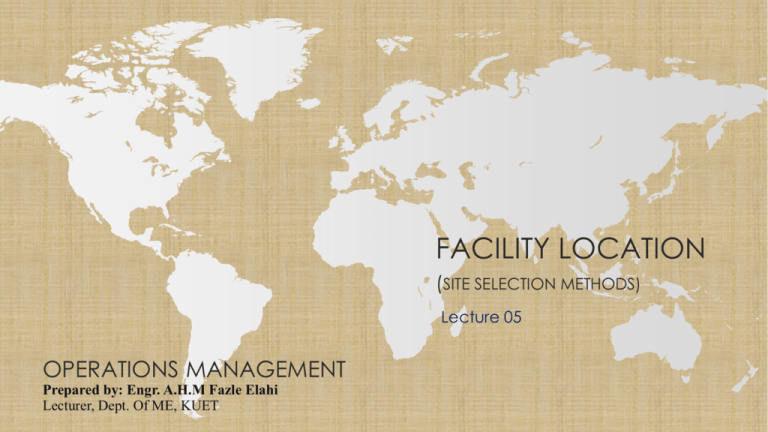
FACILITY LOCATION (SITE SELECTION METHODS) Lecture 05 OPERATIONS MANAGEMENT Prepared by: Engr. A.H.M Fazle Elahi Lecturer, Dept. Of ME, KUET LOCATION MODELS • Various models are available which help to identify the ideal location. Some of the popular models are: 1. Factor rating method: A method for identifying & weighing important location factor. The decision where to locate is based on many different types of information & inputs. 2. Weighted factor rating method: In this method to merge quantitative and qualitative factors, factors are assigned weights based on relative importance and weightage score for each site using a preference matrix is calculated. The site with the highest weighted score is selected as the best choice. 3. Load-distance method: The load-distance method is a mathematical model used to evaluate locations based on proximity factors. A method of evaluating different locations based on the load being transported & the distance. LOCATION MODELS (CONT’D) 4. Centre of gravity method: Centre of gravity is based primarily on cost considerations. The center of movement in the geographic area based on transport weight & distance. 5. Break-even analysis: Break even analysis implies that at some point in the operations, total revenue equals total cost. Break even analysis is concerned with finding the point at which revenues and costs agree exactly. It is called ‘Break-even Point’. A new advanced model named Geographic Information Systems (GIS) is used currently in almost all organization to select suitable location. LOCATION MODELS (CONT’D) GIS: Geographic Information system: • Computerized system for storing, managing, creating, analyzing, integrating, and digitally displaying geographic, i.e., spatial, data • Specifically used for site selection • Enables users to integrate large quantities of information about potential sites and analyze these data with many different, powerful analytical tools. COPYRIGHT 2012 JOHN WILEY & SONS, INC. Supplement 7-4 PROCEDURE FOR SELECTING NEW LOCATION LOCATION THEORIES ALFRED WEBER’S THEORY OF THE LOCATION OF INDUSTRIES: • Alfred Weber (1868–1958), with the publication of Theory of the Location of Industries in 1909, put forth the first developed general theory of industrial location. His model states the point for locating an industry that minimizes costs of transportation and labor requires analysis of three factors: 1. The point of optimal transportation based on the costs of distance to the ‘material index’—the ratio of weight to intermediate products (raw materials) to finished product. 2. The labor distortion, in which more favorable sources of lower cost of labor may justify greater transport distances. 3. Agglomeration and degglomeration. LOCATION THEORIES (CONT’D) The Brown-Gibson Approach for Site Selection: Brown & Gibson designed a versatile approach to select new location by evaluating Subjective and Objectives factors. Logical sequence of steps: 1. Eliminate any site that does not meet the basic requirements 2. Compute OBJECTIVE factor measure (OFi ) by measuring annual cost (Ci) , and summation of reciprocal of annual cost (1/∑Ci ), and multiplying them, then get the reciprocal. 3. Determine key subjective factors and estimate their subjective-factor measure SF, for each site by a. Deriving a factor rating w J for each subjective factor (j = 1, 2,..., n) using a forced- choice pairwise comparison procedure. Accordingly, one factor is selected over another, or they are rated equal. b. Ranking each site for each subjective factor separately Rij c. Combining for each site the factor rating and site ranking, SFi =Wj * Rij LOCATION THEORIES (CONT’D) 4. Combine for each site the objective-factor measure OFi and subjective-factor measure SFi by assigning weights k and 1 - k respectively, to obtain a location preference measure (LPM), i.e., LPMi = k*(OFi) + (l-k)*(SFi) 5. Choose the best site with maximum LPM. 0<k<1 LOCATION THEORIES (CONT’D) Thanks to all




